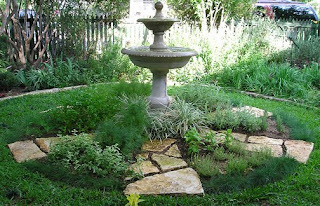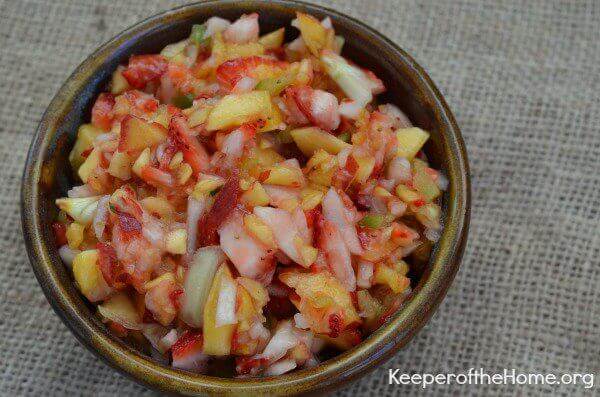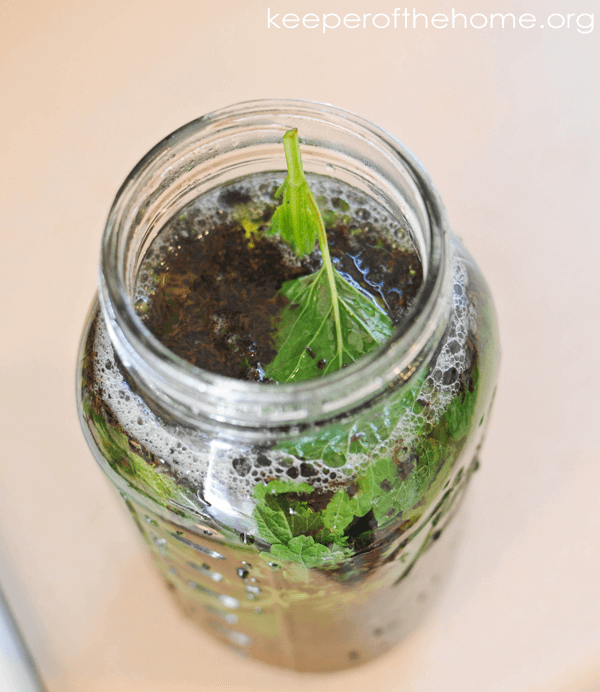Gardening with Herbs 101: Where to Begin
Written by Meg Dickey, Contributing Writer
This month at Keeper of the Home, we’re discussing Gardening 101. What better way to throw off the weariness of winter than with the joyous awakening of the earth around us? Today I’ll be sharing some tips on gardening with herbs, and next time we’ll talk about what herbs work best in different environments.
Let’s start with the basics:
WHY should I grown my own?
Growing your own herbs is easy to do, and you’ll be amazed at the difference you can taste, see, and enjoy from freshly cut herbs.
I think you’ll also be pleasantly surprised at the cost-effectiveness of growing your own. I paid $3.00 a bunch for fresh herbs at the Farmer’s Market for years before realizing I could buy a packet of organic seeds for that same $3.00 (or less).

WHERE can I grow my own herbs?
The short answer is: anywhere! Your options are only limited by your imagination (and perhaps space!). One of my favorite examples of a “plant where you can” was a flowering herb garden planted in an old wheelbarrow.
One of my original herb “gardens” was in a strawberry pot, and I loved it for it’s compact design, ease of watering, and having all my herbs in one place! Now that I have more area for gardening, I’ve been able to branch out. If you have plenty of space, here are some great ideas:
- Raised beds
- Herb wheels, which use borders to separate different sections, with a focal point at the center
- Theme gardens (which I’ll touch on next time, when we discuss the needs of specific herbs)

HOW do I grow my own herbs?
One of the many reasons why I love herb gardening is the ease with which so many of them thrive! Here are some general rules for gardening with herbs.
Soil and Light Requirements
Herbs do not require a rich soil, but the soil must drain well. A good soil blend is to add equal parts of topsoil, sand and compost. Make sure your plants receive at least 5 hours per day of sunlight.Watering
Most herbs require about 1-inch of water a week. Others such as lavender, sage, or thyme can get by with less.Fertilizing
Herbs don’t usually require fertilizer, unless you have remarkably poor soil. One of the benefits of many hardy herbs (such as lavender and rosemary) is they thrive under less than ideal conditions. We use an application of manure in the spring and a dose of compost tea in mid-summer to provide all the extra nutrients they need.Harvesting
Don’t be afraid to use your herbs! Cutting leaves and stems will make the plants become a lot thicker, fuller and more productive. Harvest early in the morning when essential oils are strongest before the sun warms the leaves, releasing the oils.Deadheading
Some herbs require deadheading the blooms in order to keep the plant productive. Basil and mint both benefit from having the flowers pinched back before they mature.Cleaning Up
After the first killing frost in autumn, pull up annual herbs such as basil. In spring, cut back dead stems on perennial herbs like mint. In the spring, prune overgrown herbs by removing about one-third of the plant before new growth begins.
WHAT herbs do I grow?
This is my favorite part of gardening! You can decide to do a mix of a few herbs, or be specific in your plantings, also called theme gardening. I particularly enjoy doing theme gardens, since I think it appeals to my organizational side, but you can plant whatever meets your needs.
You also need to take into account the area in which you live. You can find much of the information you’ll need at your local extension office, or ask around at the garden stores.
We’ll talk more about this next time, so stay tuned!
Do you grow herbs in your garden? Which ones are your favorites?
top photo credit
Other Related Posts You May Enjoy
- Gardening with Herbs 101: What To Grow
- A Tale of Two Gardens part one and part two
- How to Plan Your Garden part one and part two
- Organization in the Garden: Evaluating What You Have and What You Need
- Getting Organized in the Garden: Seed Starting and Planting Schedule
- Naturally Controlling Pests in the Organic Garden
- 5 Steps to Being a Lazy Gardener
- Gardening in Less-than-Ideal Spaces
- 7 Gardening Lessons from a Novice Gardener
- Selecting Seeds for Garden Success
- How to Plant a Garden that Works for Where You Live
- 7 Reasons to Square Foot Garden
- Plan & Plant Now for Sustainability, Freedom, and a Backyard Revolution






awesome post. It’s easy enough I think I could actually do this! 😉
Sarah M
i’m so excited for spring! i want to jump up in the air and click my heels… i’m that excited! and this post is only adding to my excitement. 🙂 great job.
i inherited two earth boxes from my grandma and that is going to be my herb garden this year. i can’t wait! i have to grow basil and lots of it for pesto. i’ve grown a bit of this and a bit of that the past few years, but basil is my only must have. i’m looking forward to your next post to help me decide what else to plant.
@stacey, Basil is my must-have, too!
I’m excited that you’re writing about herb gardening, Meg, because it’s definitely my weaker area and one that I want to grow in. I just love fresh herbs, but truthfully haven’t played around nearly enough with growing them.
I love the idea of theme gardening and I’m excited to read the post next week!
I love growing herbs. It’s the only thing I’ve ever gardened and I’ve even been able to do it in a little graduate student housing apartment on the windowsill.
@Christine, My college roommate and I pushed the screen out of the window in our dorm room, just enough to slide 4 pots of herbs in the sill. 🙂 The RA didn’t report us… as long as we shared our fresh mint with her! 😉
i love growing herbs. i had a hard time growing basil from seeds, however, so i switched back to growing it from a small plant. any suggestions for doing it from seed?
@charis, You can do it in small pots inside, but I haven’t had good luck with it from seed either… although I haven’t had to start from seed in a while – my basil self-plants. 😉
Basil has cold feet. Basil seed need warm soil to germinate well. I usually start it in a flat inside and moisten with warm water the first few times.
I love growing herbs, and this year will expand my herb garden and we’re having a vegetable garden for the first time.
I’ve always grown my herbs in containers, but this year I think I’m going to plant in this little place in the front of our house. I plan on having wild flowers in the middle and herbs all around the sides. I’ll probably keep my rosemary and mint in containers since I’ve seen them take over a garden before…but then again, I may plant the bush type of rosemary (and maybe lavender) in the garden so it will stay pretty all year long.
thanks for a wonderful post. I’ve always been a bit confused on harvesting my basil. do I cut from the top or do I cut the larger leaves from the bottom? I’ll have to look that up.
Thanks for sharing. I’m so ready to start planting!!
@Wendy, I have my mint and rosemary in pots as well – they creep and crawl all over my garden. 🙂 I pinch off the top of my basil plants – you’re looking to create a “bush” effect, so you want to take all the top and out sides off first. I only take the bottom leaves when I run out of the others 😉
I enjoyed the post today. I am looking forward to seeing my seeds sprout. I planted my cauliflower, broccoli and carrots today. Hope it wasn’t too early for my part of Texas (SE). I have tomatoes, peas, pole beans and bush beans started from seeds. Can’t wait to get them in the ground soon.
Thank you for all the information. I can always learn something new everyday.
I’m looking forward to future posts on herb gardening. We’ve never used fresh herbs before so I’m not even sure what I need to be growing, but I figure it’ll be fun either way.
We’ve just got our first batch of seeds sprouting (tomatoes, lettuce, strawberries) and hit up a local garden shop yesterday for supplies to plant more. I know I saw my herb seeds somewhere around here yesterday… I need to go find them and get them started.
This is a very interesting article! thanks for sharing much information.